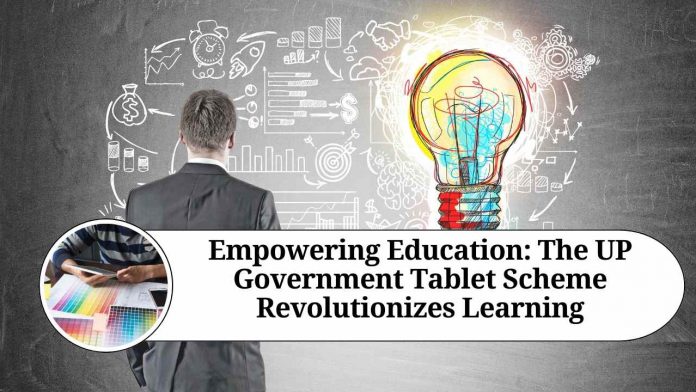Introduction
In an era dominated by digital technology, access to digital devices and the internet has become a necessity for education. Realizing this, the Uttar Pradesh (UP) government took a visionary step towards transforming education and bridging the digital divide among students. The UP Government Tablet Scheme, launched with the aim of providing tablets to students, has emerged as a game-changer in the state’s education sector. This blog explores the significance, objectives, benefits, and impact of the UP Government Tablet Scheme.
Objective of the Scheme
The primary objective of the UP Government Tablet Scheme is to enhance the accessibility and quality of education in the state. By providing tablets to students, the government aims to empower them with digital learning resources, enabling them to access educational content, digital textbooks, interactive learning applications, and online resources. The scheme also aims to promote digital literacy among students, preparing them for the increasingly digital world and equipping them with essential skills for the future.
Key Features and Benefits
- Access to Digital Learning Resources: One of the significant benefits of the scheme is that it provides students with access to a vast array of digital learning resources. Students can explore e-books, online tutorials, educational apps, and interactive multimedia content, opening up new avenues for self-paced learning.
- Enhanced Learning Experience: Tablets offer a more interactive and engaging learning experience compared to traditional textbooks. With multimedia content and interactive applications, students can grasp concepts more effectively, making the learning process enjoyable and stimulating.
- Bridging the Digital Divide: The scheme aims to bridge the digital divide by providing tablets to students who may not have access to such devices otherwise. By ensuring equal access to technology, the government aims to create a level playing field for students across different socio-economic backgrounds.
- Cost Savings on Textbooks: The distribution of tablets eliminates the need for traditional textbooks, resulting in cost savings for both students and the government. E-books and digital textbooks are often more affordable and can be regularly updated, ensuring students have access to the latest information.
- Skill Development and Future Readiness: The scheme contributes to the development of digital skills among students, which are essential for their future careers. By familiarizing students with technology and its applications, the scheme prepares them to adapt to the evolving job market and technological advancements.
Impact and Future Prospects
The UP Government Tablet Scheme has already made a significant impact on the education landscape in Uttar Pradesh. By equipping students with tablets, the scheme has created an enabling environment for e-learning, encouraging self-study and research-oriented approaches. It has also helped in reducing the burden of heavy backpacks by replacing multiple textbooks with a single device.
Moreover, the scheme has facilitated connectivity between students, teachers, and educational institutions. With internet connectivity, students can participate in virtual classrooms, engage in collaborative projects, and communicate with their peers and teachers more effectively.
Looking ahead, the UP Government Tablet Scheme holds immense potential for further advancements in the education sector. The government can leverage the tablets to introduce personalized learning approaches, adaptive assessments, and real-time feedback systems. Additionally, by integrating the tablets with the existing education infrastructure, the government can monitor student progress, track attendance, and provide targeted interventions for individual students.
Conclusion
The UP Government Tablet Scheme represents a progressive step towards transforming education in Uttar Pradesh. By equipping students with tablets, the scheme aims to bridge the digital divide, enhance the learning experience, and prepare students for the digital age. As the scheme continues to evolve, it has the potential to revolutionize the education sector in Uttar Pradesh, opening up new horizons of knowledge and opportunities for students across the state.
Read more useful content:
Frequently Asked Questions (FAQs)
Q1: Who is eligible to receive a tablet under the UP Government Tablet Scheme?
A1: The scheme is generally targeted towards students enrolled in government schools and colleges in Uttar Pradesh. Eligibility criteria may vary, but it primarily focuses on students from economically disadvantaged backgrounds.
Q2: How can students apply for the UP Government Tablet Scheme?
A2: The application process for the scheme is typically conducted through the respective educational institutions. Students need to fill out the application form provided by their school or college and submit the necessary documents as required.
Q3: What kind of tablets are provided under the scheme?
A3: The specific model and specifications of the tablets may vary depending on the government’s procurement decisions. However, the tablets provided generally have features suitable for educational purposes, such as decent processing power, sufficient storage, and connectivity options.
Q4: Are the tablets provided to students free of cost?
A4: Yes, the tablets are provided to eligible students free of cost as part of the government’s initiative to promote digital education and bridge the digital divide.
Q5: Can students keep the tablets permanently?
A5: Yes, the tablets are meant to be the personal property of the students. They are not required to return the tablets to the government or educational institutions after a specific period.
Q6: What kind of educational content is available on the tablets?
A6: The tablets are preloaded with educational content, including digital textbooks, interactive learning apps, reference materials, and other relevant resources. Students can access a variety of subjects and topics to support their studies.
Q7: Are the tablets connected to the internet?
A7: Yes, the tablets are generally equipped with internet connectivity options such as Wi-Fi and/or cellular data. This enables students to access online educational resources and participate in virtual learning activities.
Q8: Are there any guidelines or restrictions on the usage of the tablets?
A8: Yes, there are usually guidelines provided to students regarding the responsible and appropriate use of the tablets. Students are expected to use the tablets primarily for educational purposes and follow the code of conduct specified by their educational institutions.
Q9: Can students install additional applications or software on the tablets?
A9: The extent of customization and installation of additional applications may vary. In some cases, the tablets may be locked down to prevent unauthorized modifications, while in others, students may have the freedom to install relevant educational applications.
Q10: What support services are available for students regarding the tablets?
A10: Educational institutions often provide technical support and assistance to students regarding the usage of the tablets. Students can reach out to designated support staff or contact helpline numbers for any issues or queries related to the tablets.




















